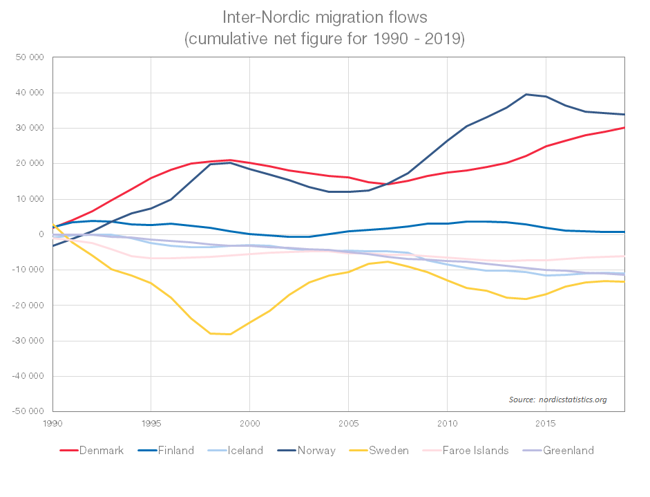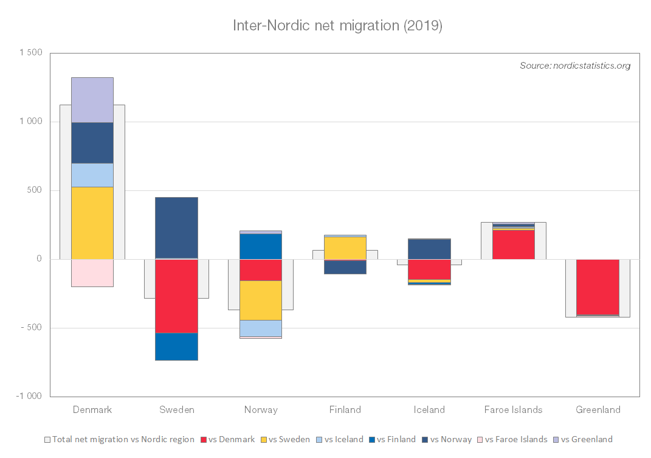Who goes where in the Nordic region?
The Nordic countries make up a relatively small but dynamic segment of the European Union in terms of population. The Nordic Ministers for Co-operation have a declared vision to be the most sustainable and integrated region in the world by 2030.
One of the aspects of being an integrated region is mobility among citizens within the region. This post describes inter-Nordic migration.
Who goes where in the Nordic region?
Every year around 40,000 people migrate between the Nordic countries and regions.[1] In the early 2000s migration flows were slightly higher, with a peak of roughly 55,000 in 2011.[2] The trend in migration flows since the 1990s varies somewhat in the different Nordic countries.
Figure 1 below shows how net migration, i.e. the difference in the number of people immigrating and the number emigrating, has changed between 1990 and 2019. The diagram shows net migration as a cumulative net figure. A cumulative net figure means that the net migration every year is added to the figure from the previous year(s). A positive trend, i.e. the cumulative net migration increases during the period, means that over the period as a whole the country has experienced higher immigration from the other Nordic countries than emigration to the other Nordic countries.

Figure 1. Cumulative inter-Nordic net migration. The net migration for each country constitutes the difference between immigration and emigration from or to another Nordic country or region. The diagram shows cumulative net migration over time for 1990 to 2019.
The net migration in Sweden and Norway displays the largest variation during the period in question. All the Nordic countries, apart from Greenland, have had both positive and negative net migration. This means that all the countries have sometimes had higher immigration than emigration to/from the other Nordic countries, and at times vice versa. During the whole period Greenland has had a negative inter-Nordic net migration, meaning that more people have moved from than to the country each year.
Since 1990, Norway and Denmark have experienced overall positive net migration, i.e. more immigration from than emigration to the other Nordic countries in total over the period. Sweden, Iceland, Greenland and the Faroe Islands have seen greater emigration to than immigration from the other Nordic countries overall during the same period. Finland, which had an in Nordic terms relatively low combined net migration during the period, especially in relation to its total population, ended the period with a steady net migration of close to zero.
In addition to the fact that the scope and trend of inter-Nordic net migration differs between the Nordic countries, the migration flows between the countries also look different.
Figure 2 shows inter-Nordic net migration for 2019, broken down by how the migration flows looked to each of the other Nordic countries, together with the country’s total inter-Nordic net migration.

Figure 2. Inter-Nordic net migration for 2019, based on migration country. The net migration for each country constitutes the difference between immigration and emigration from or to another Nordic country or region. The coloured segments in each country’s column show the net migration between the specific country and each of the other Nordic countries. Segments below the zero line indicate that emigration was greater than immigration to the country, and columns above the zero line indicate that immigration from was higher than emigration to a certain country. The grey columns show total in
Note: Sweden reports persons moving from and to the Faroe Islands and Greenland to Denmark. This difference in statistical reporting is deemed to be negligible in this context, as the equivalent net migration, i.e. net migration from the Faroe Islands and Greenland to/from Sweden was 13 and 1 respectively in 2019.
The diagram reveals that Denmark has the highest positive net migration for 2019, followed by the Faroe Islands. Greenland has the highest negative net migration, followed by Norway.
Sweden shows negative net migration for 2019, with positive net migration to/from Norway that is offset by slightly higher negative net migration to/from Denmark. Denmark, on the other hand, draws the most immigrants from Sweden, followed by Greenland and Norway. More people move to the Faroe Islands from Denmark than the reverse.
[1] The text below refers to “the Nordic countries”, which includes Greenland and the Faroe Islands, unless otherwise specified.
[2] As people have more of a tendency to register in the country they move to rather than reporting their departure in the country they move from (for practical reasons such as accommodation, bank account and social security), there is often a discrepancy between the figures for immigration and emigration. This discrepancy in the statistics is generally not significant.